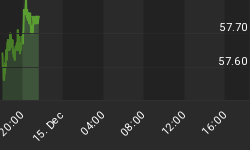The following is excerpted from a commentary originally posted at www.speculative-investor.com on 26th May 2013.
One of the simplest and best ways to ascertain gold's long-term trend is to look at its performance relative to commodities in general. This is because a genuine gold bull market will result in gold making higher highs and higher lows relative to most other commodities. Alternatively, if gold is trending higher in nominal currency terms but not against most other commodities, then what we have is a general inflation-fueled commodity bull market (all long-term commodity bull markets are fueled by monetary inflation) with gold going along for the ride. In this latter case, the rise in the gold price is nothing more than an offset to the loss in purchasing power of the currency. So, let's review gold's performance against the Continuous Commodity Index (CCI).
The following chart of the gold/CCI ratio makes it clear that a long-term gold bull market commenced at the beginning of 2001. The chart also makes it clear that gold's long-term bull market has contained substantial intermediate-term swings as well as multi-year periods of 'choppy' sideways movement. In other words, despite the impression created by long-term charts of the US$ gold price, gold's progress since its early-2001 major bottom has been anything but steady.

While short-term fluctuations are often random, the major turning points and swings in the gold/CCI ratio are intimately related to important happenings on the monetary, economic and financial-market fronts. Of particular note:
1) Gold's long-term (secular) bull market began several months after the secular bull market in US equities ended. This was not a fluke. Secular gold bull markets invariably coincide with secular equity bear markets, where a secular equity bear market is defined as a 1-2 decade period during which equity valuations (not necessarily equity prices) trend downward. A consequence is that gold's secular bull market will almost certainly continue until shortly before or shortly after equity valuations reach their nadir. It's reasonable to expect that this point lies at least a few years into the future, because valuations are now high and at no time over the past 10 years has the average equity valuation come remotely close to the level at which previous secular bear markets ended.
2) There was a strong 18-month rise in gold/CCI from the beginning of 2001 through to mid-2002. Not coincidentally, this period was the main part of the economic and financial-market bust that inevitably followed the inflation-fueled boom of the 1990s.
3) Another financial-market and economic boom got underway in 2003 and persisted, in fits and starts, until the first half of 2008. During this 5-year period the gold price trended higher in US$ terms, but relative to most other commodities gold did no more than hold its own. Hold its own is the best that gold can reasonably be expected to do during the boom phase of the boom-bust cycle.
4) The 2003-2007 boom was fueled by aggressive 'monetary accommodation' designed to mitigate the fallout from the 1990s boom. Inevitably, it led to another bust. In fact, it led to an economic and financial-market bust that dwarfed the 2000-2002 episode. Just as inevitably, it led to a much stronger advance in the gold/CCI ratio and an even more aggressive series of monetary measures designed to mitigate the fallout from the artificial boom fomented by earlier monetary measures.
5) The global financial crisis came to an end during February-March of 2009, naturally resulting in an important peak for the gold/CCI ratio at that time.
6) Gold/CCI then corrected for about two years while the financial world breathed a collective sigh of relief and while rising stock markets created the false impression that the 'monetary accommodation' put in place to mitigate the latest bust would set the stage for a genuine self-sustaining recovery.
7) In 2011, doubt about the economic recovery began to emerge and the gold/CCI ratio resumed its bull market. In this case, the main source of the doubt was the euro-zone. The markets began to discount the possibility of government debt default and large-scale banking failure within the euro-zone.
8) Fears of euro-zone government debt default and banking collapse peaked in mid-2012, and so, understandably, did the gold/CCI ratio.
9) The financial world is now well into another period during which rising stock markets create the false impression that 'monetary accommodation' is setting the stage for a self-sustaining recovery. We can be sure that the impression is false because the monetary accommodation is the cause of the price distortions that in turn cause the boom/bust cycle (the bust is nothing more than an attempt to correct the distortions that arise during the boom). The more aggressive the monetary accommodation put in pace to mitigate the economic pain stemming from one bust, the bigger the next bust and the next rise in the gold/CCI ratio are bound to be.
The current careening from bust to boom to greater bust will only end after there is widespread understanding that it makes no sense to suppress interest rates and create a lot of money out of nothing in an effort to fix problems caused by suppressing interest rates and creating a lot of money out of nothing. We seem to be a long way from that point, which all but guarantees that we are a long way from the end of gold's bull market.
We aren't offering a free trial subscription at this time, but free samples of our work (excerpts from our regular commentaries) can be viewed at: http://www.speculative-investor.com/new/freesamples.html
















